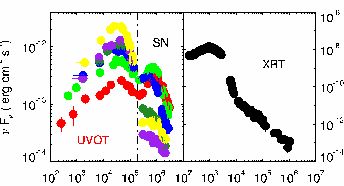Low-Luminosity Gamma-Ray Bursts could be the candidate sources of ultra-high-energy cosmic-ray heavy nuclei, which are accelerated in the shock. High-energy photons emitted from these nuclei through photodisintegration process provide indirect evidence for nuclei’s acceleration. We model the photodisintegration-induced TeV photon emission from low-luminosity gamma-ray bursts and discuss the detectability by the high-energy observatories such as Fermi, H.E.S.S and CTA etc.


Upper panel: UVOT and XRT afterglows of GRB060218/SN2006aj observed by the Swift satellite. The “SN” denotes the supernova light curve at tens of days. Lower panel: the multi wave band emission of SN2006aj by placing it at a distance of 10kpc. The work by LIU Xuewen ,WU Xuefeng,has been accepted to be published in ASTRONOMICAL JOURNAL 2012 .Vol.143. No.5 .pp.115
(http://apps.webofknowledge.com/full_record.do?product=UA&search_mode=GeneralSearch&qid=1&SID=Y22HdCOBc5@aMH186AL&page=1&doc=6) |
